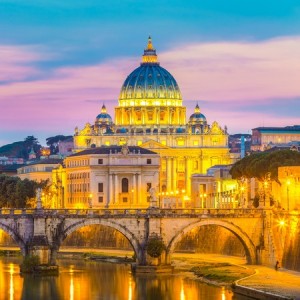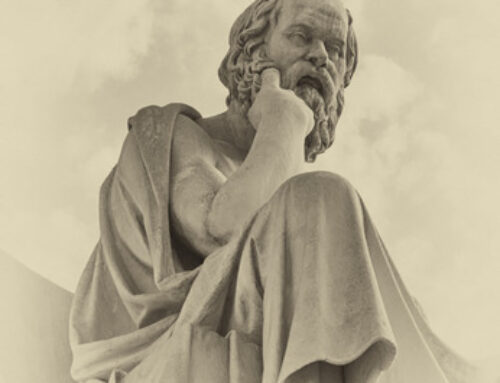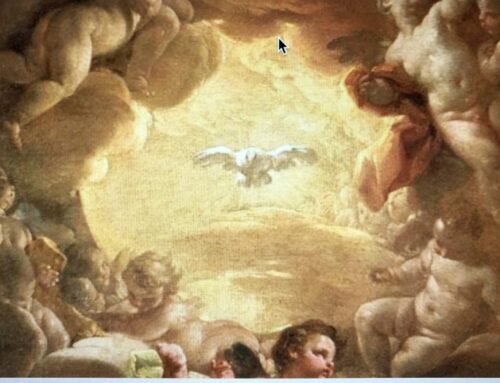 A Perfect Storm is defined as “a critical or disastrous situation created by a powerful concurrence of [movements].” A Perfect Theological Storm differs only in the time required for the concurrence: decades rather than hours. Such a storm has been gathering in the Catholic Church for well over a century. This essay will identify its movements, explain their relationships, and identify the timeline of their unfolding.
A Perfect Storm is defined as “a critical or disastrous situation created by a powerful concurrence of [movements].” A Perfect Theological Storm differs only in the time required for the concurrence: decades rather than hours. Such a storm has been gathering in the Catholic Church for well over a century. This essay will identify its movements, explain their relationships, and identify the timeline of their unfolding.
First, a quick review of the relevant historical background. Over several centuries leading to the 1700s, Feudalism was replaced by Capitalism, which was strengthened by the Industrial Revolution. Capitalism is characterized by private ownership of property and production and by free markets through which income is distributed. In the early 1800s Socialism, which arose out of concern over the exploitation of workers by the upper class, sought community ownership of property and production. Later in the century Karl Marx took a more aggressive view of Socialism—as a revolution in which the working class seized control of property and production. Communism is an extreme form of Socialism and is characterized by government takeover of private property and production and centralized control of all aspects of the country’s economy.
The Catholic “theological storm” began when Socialism was gaining a following, and in fact is related to it. The movements that comprise that storm are Social Justice theory, Community Activism, Humanistic Psychology, Liberation Theology, Seamless Garment theory, and Critical Race theory. Taken together, these movements have significantly changed the Catholic Church in ways the hierarchy generally embrace, yet many laypeople and priests find troubling. Over the last half-century, that gap between the hierarchy and the laity has continued to widen. A closer look at each of these movements will reveal why.
SOCIAL JUSTICE THEORY: The term “justice” is mentioned many times in the Bible. The term “social justice” (coined in the mid-1800s) is not mentioned at all, nor was it mentioned in the Baltimore Catechism. The difference between the terms is significant: “Justice” can be dispensed by individuals; “Social Justice” requires government enforcement and is thus closely related to Socialism and Communism. Jesuit priest Luigi Taparelli (d. 1862) was an early proponent of “social justice” as were his Jesuit successors. The term has been included in Catechisms after “Baltimore”, and was used by Pius XI in Quadragesimo Anno (1931). In 21st century Catholic writings, “Social Justice” has largely replaced the biblical term “Justice.” A notable example is passage numbers 1943-1948 of the current edition of the Catechism, which link “social justice” to the requirement of “reduc[ing] excessive social and economic inequalities.” Phrasing such as this is commonly used by the U.S. Conference of Catholic Bishops (USCCB) and has the effect of shifting doctrinal focus from individual action to group “obligation” of the state. Therefore, whether intentionally or unintentionally, it endorses a fundamental precept of Socialism.
COMMUNITY ACTIVISM is “the means through which individuals, groups, and organizations work together to bring about specific, often radical, changes in social, economic, environmental, and cultural policies and practices.” It is distinguished from “community service” in that it focuses primarily “changing underlying or contributing structures, practices, or policies.” [Emphasis added]
The best known community activist in the U.S. was Saul Alinsky, who though an atheist devotee of Marxism, had strong influence on Catholic social policies and, because of that, on Catholic moral theology. Alinsky drew his goals and techniques from three forms of Socialism: The Frankfurt School that was among “the initiators of what we’ve come to know as the sexual revolution”; the Antonio Gramsci School, that “focused on an attack on religion, a attack directly on God . . . [in order] to secularize society”; and the Fabian School, which focused on undermining Capitalism.
Alinsky recruited many priests and prelates for this effort in the 1950s, a relatively easy task given that many were already in place: according to former Communist Bella Dodd’s testimony in School of Darkness, “In the 1930’s we put eleven hundred men into the priesthood in order to destroy the Church from within. Right now [the 1950s] they are in the highest places in the Church.” (See this EWTN video.)
Among the priests and prelates associated with Alinsky’s efforts were Fr. Jack Egan, Fr. Tom Gaudet, Cardinal Samuel Stritch, Cardinal John Dearden, and Cardinal Joseph Bernardin (who called Alinsky “an inspiration” to the Catholic Campaign for Human Development). Alinsky managed to attract these influential Catholics despite his commitment to lying to retain an advantage, being “a clever counterfeit and hypocrite,” doing “what [one] can and cloth[ing] it in moral garb,” and proclaiming “If there is an afterlife and I have anything to say about it, I will unreservedly choose to go to hell.” One follower, Jesuit Fr. Mitch Pacwa, cut off his relationship when he realized that Alinsky’s method “stirred up enmities” and “divorced itself from standard morality” by focusing only on “help these poor people, whatever it takes.” [Emphasis added] But many others in the Church chose to remain followers .
HUMANISTIC PSYCHOLOGY (HP) came to prominence in 1961 with the publication of Carl Rogers’ On Becoming a Person. He and Abraham Maslow were leaders of the new psychology, which was widely considered more favorable to religion than were Freudianism, Behaviorism or Existentialism. Catholic orders of priests and nuns embraced the new psychology enthusiastically but incautiously, not realizing the danger it posed for the Church. Among the messages of HP were that truth and reality are not objective but subjective—in other words, that people create their own truth and whatever opinions they form about, for example, morality, are valid—and that feelings are more reliable than reason. Also, that high self-esteem is essential to achievement and, by implication, humility is an obstacle. Far from complementing Catholic beliefs, these views undermined them. (See Ruggiero, Corrupted Culture.)
Legions of authors spread and often expanded the HP message. Patrick Fanning preached that parents tend to create a “tyranny of the shoulds” that blocks self-esteem. Deepak Chopra rhapsodized,“A wizard exists in all of us . . . sees and knows everything. . . [and] has no rules.” Peter McWilliams called traditional beliefs ‘learned junk’ inflicted by authority figures. Psychiatrist M. Scott Peck advised, ‘To put it plainly your unconscious is God. God is within us.” Psychiatrist David Burns advocated a therapy focused on “understanding your moods,” “feeling good about yourself,” “feeling confident,” and “feeling good together.” Protestant minister Robert Schuller claimed that “the will to self-love is the deepest o fall human desires,” that “the core of original sin . . . could be considered an innate inability to adequately value ourselves,” and that what Christ meant when he said “deliver us from evil” was deliver us from “a negative self-image, a lack of self-esteem,” and “man’s deepest need [is] the will to self worth.”
This is just a small sample of the exaltation of self-esteem that has gone on for well over fifty years, and during that extended time there have been few if any significant challenges to it by the Catholic hierarchy, yet I can recall more than one statement like this from the pulpit: “We must love ourselves before we can love our neighbor.”
LIBERATION THEOLOGY is a melding of Marxist sociology and economics with theology that originated in the 1960s with South American priest-theologians Dominican Gustavo Gutiérrez and Franciscan Leonardo Boff. It was then championed by Jesuits Juan Luis Segundo, Jon Sobrino, Father General Pedro Arrupe and, under his leadership, innumerable other priests. One of them, Fr. Francis Carney, urged Christians to be more supportive of “armed revolution, socialism, Marxism, and communism.” Liberation Theology aims at political rather than spiritual reform. As I have previously explained, “it is based on a number of false assumptions—notably that human beings are inherently wise and good and all their problems are caused by outside agencies or economic systems (such as capitalism); that the individuals championing the liberation are themselves incorruptible; that the end of liberating the oppressed justifies the means of torture, murder, and terror; and that the liberation will eliminate oppression, rather than merely install a new group of oppressors.”
In 1984, while still a Cardinal, Pope Benedict recognized the errors of Liberation Theology, which he examined in the essay “Liberation Theology: Preliminary Notes.” But despite Benedict’s warning, that theology continues to be supported by many in high Catholic offices, including in the Vatican, as evidenced by their continuing emphasis on the phrase Gustavo Gutiérrez coined for the movement, “preferential option for the poor.”
SEAMLESS GARMENT THEORY. Also known as the “consistent ethic of life,” this ideology was articulated by Catholic activist Eileen Egan in 1961 and popularized by Cardinal Joseph Bernardin beginning in 1983. “Seamless Garment” is a reference to Jesus’ robe described in John 19:23. The main idea of this movement is that since both abortion and capital punishment offend the principle of reverence for life, both should be equally condemned; furthermore, that movements that oppose abortion but accept capital punishment are acting irrationally. This way of thinking challenges the traditional view of Catholic theology that abortion destroys innocent human life, whereas capital punishment does not. Archbishop José Gómez of Los Angeles criticized Seamless Garment Theory” in 2016 because in his view it results in “a mistaken idea that all issues are morally equivalent.” In other words, the theory is based on Relativism, which the Church has rejected. However, despite the Archibisop’s opposition, the USCCB has supported the theory and chastised groups like Priests for Life that focus exclusively on abortion.
CRITICAL RACE THEORY (CRT). CRT formally began in the 1980s in the legal community. Among its main tenets are ”that the law and legal institutions are inherently racist and that race itself . . . is a socially constructed concept that is used by white people to further their economic and political interests at the expense of people of colour.” Whites are said to “create . . . social, economic, and legal differences” that cause “poverty and criminality in many minority communities.”
CRT is largely responsible for the widespread use of the term “systemic racism,” which many in the media have used profusely in their narratives about race, and done considerable mischief in the process. The term is not only inflammatory but false. There are good, decent, caring white people as well as hateful ones, and honorable, welcoming institutions as well as corrupt ones; thus, though racism exists, and even a little of it is too much, it is more than misleading to speak of it as “systemic.” Unfortunately, the Catholic hierarchy often use that very term, and sometimes the entire media narrative about race. For example, a Connecticut bishop wrote this to his diocesan community: “As the nation reels from the death of George Floyd in Minneapolis and the protests and rioting that have followed, we must once again confront the evil of systemic racism, bigotry, and discrimination in our country.” [Emphasis added]
And here is a similar use by the U.S. Conference of Catholic Bishops: “One area of systemic racism is unequal access to decent housing. . . Today’s continuing inequalities in education, housing, employment, wealth, and representation in leadership positions are rooted in our country’s shameful history of slavery and systemic racism.” [Emphasis added]
Even worse than the hierarchy’s use of misleading language about the nature of the race problem is their general failure to criticize priests and religious who openly support support CRT. For example, a Catholic Nun (and theology professor) lecturing students in an Oregon public school on CTR and using the terms “systemic racism,” “institutional racism,” white privilege,” “white body privilege,” “black body trauma,” “white frame,” and “patriarchy,” and referring to Europeans as “conquerors” and to slavery as “our original sin.” During the lecture she handed out a reading list of largely CTR writings. I could find no response by Catholic prelates condemning her presentation or any similar one. (For more on the Bishops shortcomings regarding race, see here.)
Like any major storm, the theological storm in the Catholic Church has left devastation in its wake. To be more specific, it has resulted in the hierarchy creating or exacerbating a number of social and moral problems:
By trading the biblical concept of justice for the antithetical concept of “Social justice,” the Catholic hierarchy have given false credibility to the socialist program of “redistribution of wealth,” undermined the work ethic, promoted a sense of entitlement and envy, and increased racial and ethnic disharmony.
By supporting open borders rather than economic and social reforms in poor countries, the hierarchy have done a disservice to rich and poor nations alike and rather than honoring the Gospel of Christ, have and made straight the way to anarchy and Socialism.
By ignoring Catholic teaching on “ends and means” and embracing the immoral methods of atheist Saul Alinsky’s “community activism,” the hierarchy have sowed disharmony and division and undermined the stability of democratic republics.
By tacitly approving Humanistic Psychology’s view of truth and reality being created rather than discovered, emotion being more reliable than reason, and self-esteem being more important than self-improvement, the hierarchy have severely weakened the Church’s intellectual and moral teachings and obscured the distinctions between wisdom and foolishness, virtue and vice.
By failing to offer vigorous opposition to Liberation Theology, Seamless Garment Theory, and Critical Race Theory, the hierarchy have allowed the biblical emphasis on acknowledging and overcoming one’s own sins to be replaced with the political emphasis on overcoming societal faults, and have thus encouraged extreme and sometimes violent reactions both to real evils such as discrimination and imagined ones such as “systemic racism.”
Taken together, these hierarchal failings have aided and abetted progressive politicians’ efforts to weaken the Constitution and replace America’s free market economy with Socialism and Christianity with secularism. These failings have also led many Catholic educational institutions to relinquish their Catholic identity, created moral confusion among clerics and lay people alike, and caused many to lose faith in the Catholic Church.
Copyright © 2021 by Vincent Ryan Ruggiero. All rights reserved


